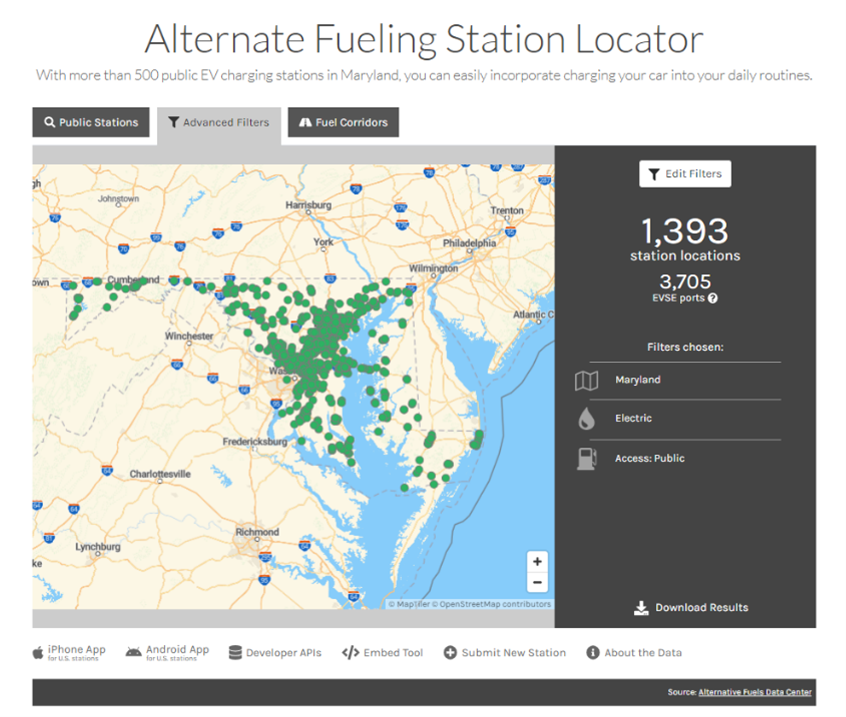[Part 1 of 2]
Introduction
The U.S. auto market experienced an exponential growth of electric vehicles (EVs) in recent years, with sales in 2022 increasing 55%. On a Marylander’s daily commute this development is increasingly noticeable. Whether zipping down I-95 or traversing the spiraling streets of Montgomery and Prince George’s County, drivers of traditional internal combustion engine vehicles are increasingly accompanied by their battery driven counterparts.
The EV that first comes to mind for many is Tesla. The Texas based auto manufacturer is a forerunner in the EV revolution since its first vehicle launch in 2008 and has pioneered the market in its manufacturing processes, EV technology, and influence on public perception towards EVs. While Tesla helped lay the foundation for the US EV market, we are entering a new period of rapid transformation. Emerging competition and the continual saturation of the EV market correspond with wider implications than merely affecting Tesla’s gradually slipping profit margins, which took a 10% hit within one year. The once unequivocally dominating Tesla experienced a notable drop, from 72% (Q1 2022) to 58% (Q1 2023). The long-established U.S. automakers as well as numerous imports are progressively ramping up production of their EV models. Coinciding with escalation in EV investment, auto-manufacturers have increasingly announced major decisions regarding the future of their production.
In US and global markets, economic push and pull factors are compelling automakers to both brace for and embrace the future. A growing number of countries have taken regulatory steps towards enacting restrictions on activities that produce considerable carbon emissions and contribute to global climate change. According to the EPA, the transportation sector accounts for 29% of total US greenhouse gas emissions and “increased more in absolute terms than any other sector between the years 1990 and 2021.” Subsequently, sixteen states and Puerto Rico have enacted legislation establishing greenhouse gas (GHG) emissions reduction requirements. Other states introduced non-binding GHG reduction goals and monitoring efforts from state agencies. However, a “stick” approach to environmental governance can only go so far. Thus, we’ve seen a resounding call for the need to provide the market with both incentives and assistance to better transition to sustainable practices. These incentives have the effect of easing the costs associated with transitioning production and operation, as well as encouraging continual investment in the areas of research and development. In Washington D.C., bi-partisan strides have been made towards legislation promoting sustainable technologies. Resultantly, new legislation such as the Inflation Reduction Act provides incentives to reduce renewable energy costs. In tandem, the Bipartisan Infrastructure Law invests a combined $24.5 billion in EV charging, clean transportation, and EV battery production and technology. This combination of factors also contributed towards motivating auto manufacturers to create benchmarks for switching lines of their production to EV, or timelines for completely phasing out combustion engine models. GM is taking the latter approach, with plans to phase out all internal combustion engine models by 2035. With GM’s CEO and Chairman Mary Barra stating, she believes “the auto industry will change more in the next five to ten years than it has in the last fifty.” On the other hand, Ford is taking a mixed approach by splitting its auto business into separate units. Ford “Blue” will continue the manufacture of traditional gas- and diesel-powered vehicles. While at the same time, Ford Model E will intensify EV production goals and continue to turn out models such as the Mustang Mach-E and F-150 Lightning. Ford decided to carryover these already recognizable nameplates to give the EVs a profile boost to its customer base. Keeping these ongoing transformations in mind, how can Maryland vehicle owners as well as businesses both navigate and benefit from the EV revolution?
Maryland- An Inviting Place to Make the Switch
When considering switching to EV, vehicle owners face a number of questions. How do charging and battery capabilities of a vehicle align with daily commuting and driving needs? How do costs of ownership and operation compare to savings? Does the switch make a meaningful environmental impact? Until recent innovations, the expansion of the EV market was hindered by the limited range and availability of EV models. Yet, within merely a decade there have been massive leaps in innovation in battery technology. In 2013 the average EV range in the US was 117 miles on a single charge. A decade later, this number nearly doubled, where one could expect a 219 mile range from the average EV in the US. Some upgraded models such as the 2023 Tesla Model S and Lucid Air push an impressive 405- and 516-mile range, respectively. Yet regardless of the battery capacity, there comes a time when the vehicle will need to recharge. A commuter in Chevy Chase, realizing that their gas tank is empty, faces the consequence of paying a premium for gasoline. But for an EV owner, running out of battery charge without proper infrastructure can be a greater challenge.
Recent years have seen a rise in Maryland’s public charging stations, now numbering over 1,300, tripling from merely a decade ago. Maryland drivers in comparison to many other states across the US, have access to increasingly abundant EV infrastructure and stand to benefit from state geography. Much of Maryland’s residential area lies within the periphery of two major EV infrastructure hotspots (Washington D.C. and Baltimore). This means that apart from home charging, concentrations of EV infrastructure are within their proximity. Additionally, public charging station locating tools such as MarylandEV.org[1] allow drivers to easily find nearby chargers.

Now that access to EV charging infrastructure is broadly available, how do the costs of EV ownership and operation compare? And how does modern EV technology open new doors? In a joint review conducted by members of the computer science and engineering faculties of University of Zaragoza and University of Antwerp, researchers identified several advantages that an EV offers over a traditional vehicle. First, an EV has the advantage of simplicity, smaller engine elements and simpler components, and does not require a “cooling circuit, the incorporation of a gearshift, clutch, or elements that reduce the engine noise.” This results in cheaper maintenance costs and lessens the likelihood of breakdowns from failure of components or deterioration produced from “engine explosions, vibrations, or fuel corrosion.” In combination with lower maintenance costs an EV owner can expect to pay less in operating costs, as EV’s have a lower energy cost per mile than traditional vehicles. Despite its advantages in costs over the long-term, the main shortcoming for EVs has been their considerable battery cost, which has historically hampered their price competitiveness on the market. Compared to other traditional vehicles, purchasing an EV is a higher capital investment. However, analytics published by the International Council on Clean Transportation (ICCT) projects a price parity of EV’s of all ranges with conventional vehicles in the light-duty vehicle category by 2033. The projections of the price parities are as follows: “between 2024 and 2026 for 150- to 200-mile range EVs, between 2027 and 2029 for 250- to 300-mile range EVs, and between 2029 and 2033 for 350- to 400-mile range EVs.” This resulting from continual reductions in the $/kilowatt hourly cost due to “technological advancements and increased production volumes.” In addition, the analysis published by the ICCT found that by 2025 the average EV with up to 300-mile range will have a lower 6-year cost of ownership than comparable traditional vehicles in the light-duty vehicle class.
The case for business
Business also stands to benefit from adopting early to the EV transition. For companies looking for ways to put into practice environmental values, conversion to an EV fleet or investing in charging stations are worthwhile contributions towards larger sustainability goals. A growing number of corporations operating large vehicle fleets such as FedEx, DHL, Comcast, and Amazon are making commitments towards carbon neutrality and electrifying their vehicle fleets. One possible explanation is that these companies are looking to improve their green identity, albeit one must also recognize that the underlying economic motives factor into the equation as well. For businesses, embracing a transition towards EV fits into the larger picture of creating a green brand identity. Turning words and commitments of sustainability into practice demonstrates to customers and partners that the business stands for the values that it promotes. Purpose driven businesses and adhering to stated values is an important indicator for talent attraction according to London Business School experts.[2] Today, younger generations are increasingly drawn towards responsible businesses, who are genuinely committed impact rather than solely profit-driven companies. Investing in EV charging stations also goes far in terms of employee benefits. Providing employees, the accessibility and convenience to charge at work can help bolster a business’ employee value proposition (EVP). Furthermore, taking such steps in providing valuable employee amenities helps employees feel more valued. A workforce who feels valued and appreciated brings the benefits of enhanced productivity, talent retention, along with stake in company values and goals.
Now is the time for action from business, and there are tools at their disposable to assist in making this step towards the future. The U.S. Department of Energy provides resources on the Alternative Fuels Data Center website on how to successfully implement workplace charging. This resource provides information on structural planning, technical details, management, and balancing whether employees help offset capital and operational costs associated with EV charging. Businesses in Maryland have a multitude of both Federal and States programs are their disposal. For instance, the Maryland Electric Vehicle (EV) Charging Station Rebate Program from the Maryland Energy Administration (MEA) covers 40% of the cost of acquisition and installation up to $4,000 per charging station. Federal support for businesses can be drawn from several sources, discretionary and formula grant programs, loan financing programs, and tax incentives. Notable programs for businesses include the Commercial Electric Vehicle (EV) and Fuel Cell Electric Vehicle (FCEV) Tax Credit and Alternative Fuel Vehicle (AFV) Grants for the – $5,000 to $150,000 depending on the class of vehicle. An overview of the numerous EV Federal Funding and Financing Programs provided by the U.S. Department of Transportation can be reached here. These government incentives fit into the bigger picture of the plan that Governor Wes Moore (D) and state environmental officials are using, following California’s lead in phasing out the sale of combustion engine vehicles by 2035. There is an approaching benchmark in four years’ time for Maryland car dealers, which requires that at least 43% of cars sold by Maryland dealers to produce zero emissions. Resultingly, by the year 2027, there will be a rising trend in EV sales and likewise a greater demand for EV infrastructure.
Please stay tuned for the release of the second half of the Maryland Going EV series. The next release will dive into the environmental and social impacts of EVs. Additionally, it will cover the changing shape of Maryland’s renewable energy portfolio and the complexities of non-renewable energy subsidy structures in the US.
References:
“Assessment of Light-Duty Electric Vehicle Costs and Consumer Benefits in the United States in the 2022–2035 Time Frame.” International Council on Clean Transportation, https://theicct.org/publication/ev-cost-benefits-2035-oct22/.
Barriers to Electric Vehicle Adoption: The 4 Key Challenges. https://www.exro.com/industry-insights/barriers-to-electric-vehicle-adoption-in-2022.
Beirne, Samuel. Maryland Offshore Wind Overview.
Bethlehem Steel. https://www.discoveramericablog.com/post/2019/08/18/bethlehem-steel.
California Moves to Accelerate to 100% New Zero-Emission Vehicle Sales by 2035 | California Air Resources Board. https://ww2.arb.ca.gov/news/california-moves-accelerate-100-new-zero-emission-vehicle-sales-2035.
CTPAT: Customs Trade Partnership Against Terrorism | U.S. Customs and Border Protection. https://www.cbp.gov/border-security/ports-entry/cargo-security/CTPAT.
Fact Sheet | Fossil Fuel Subsidies: A Closer Look at Tax Breaks and Societal Costs (2019) | White Papers | EESI. https://www.eesi.org/papers/view/fact-sheet-fossil-fuel-subsidies-a-closer-look-at-tax-breaks-and-societal-costs.
“Fig. 4. Well-to-Wheels Efficiency Comparison between Various.” ResearchGate, https://www.researchgate.net/figure/Well-to-wheels-efficiency-comparison-between-various_fig4_224712974.
Frequently Asked Questions (FAQs) – U.S. Energy Information Administration (EIA). https://www.eia.gov/tools/faqs/faq.php?id=10&t=5.
Gas Tax Holiday. https://www.marylandtaxes.gov/gas-tax-holiday/.
Governor Moore Announces Major Offshore Wind Energy Initiatives During International Forum in Baltimore – Press Releases – News – Office of Governor Wes Moore. https://governor.maryland.gov/news/press/pages/Governor-Moore-Announces-Major-Offshore-Wind-Energy-Initiatives-During-International-Forum-in-Baltimore.aspx.
“Here’s How Much Oil Companies Made in Profits Last Year.” CNBC, https://www.cnbc.com/video/2023/03/03/oil-companies-made-200-billion-in-profits-in-2022.html.
House, The White. “FACT SHEET: Biden-Harris Administration Announces New Standards and Major Progress for a Made-in-America National Network of Electric Vehicle Chargers.” The White House, 15 Feb. 2023, https://www.whitehouse.gov/briefing-room/statements-releases/2023/02/15/fact-sheet-biden-harris-administration-announces-new-standards-and-major-progress-for-a-made-in-america-national-network-of-electric-vehicle-chargers/.
How Much Electricity Does It Take to Charge a Tesla? — Lectron EV. https://ev-lectron.com/blogs/blog/how-much-electricity-does-it-take-to-charge-a-tesla.
Maryland Energy. https://msa.maryland.gov/msa/mdmanual/01glance/html/energy.html.
Morris, James. “Tesla’s Shift To Cobalt-Free Batteries Is Its Most Important Move Yet.” Forbes, https://www.forbes.com/sites/jamesmorris/2020/07/11/teslas-shift-to-cobalt-free-batteries-is-its-most-important-move-yet/.
“OC Supports Green & Unseen Wind Farms.” Town of Ocean City, Maryland, https://oceancitymd.gov/oc/oc-supports-green-unseen-wind-farms/.
Ohnsman, Alan. “U.S. EV Charging Network Gets $2.5 Billion Boost From Biden Administration.” Forbes, https://www.forbes.com/sites/alanohnsman/2023/03/14/us-ev-charging-network-gets-25-billion-boost-from-biden-administration/.
“Potential Economic Development Benefits from B Corps- Complete Un-Desktopped.Pdf.” Google Docs, https://drive.google.com/file/d/0B6ZFV2pjfkheeGJTZHBTVnhhMHc/view?resourcekey=0-CIQ4RP8I8fAsl2kSZ1g_bQ&usp=embed_facebook.
Reuters. “Factbox: Biden Budget to Target U.S. Fossil Fuel Subsidies.” Reuters, 9 Mar. 2023. www.reuters.com, https://www.reuters.com/business/energy/biden-budget-target-us-fossil-fuel-subsidies-2023-03-09/.
Sanguesa, Julio A., et al. “A Review on Electric Vehicles: Technologies and Challenges.” Smart Cities, vol. 4, no. 1, 1, Mar. 2021, pp. 372–404. www.mdpi.com, https://doi.org/10.3390/smartcities4010022.
Short-Term Energy Outlook – U.S. Energy Information Administration (EIA). https://www.eia.gov/outlooks/steo/report/elec_coal_renew.php.
Sparrows Point Steel. https://uswindinc.com/sps/.
“The Challenge of Sourcing EV Battery Minerals in an ESG World.” IHS Markit, 8 Mar. 2023, https://www.spglobal.com/mobility/en/research-analysis/electric-vehicle-batteries-mining-esg-ceraweek.html.
“The Chinese Auto Industry at a Crossroads.” IESE Insight, https://www.iese.edu/insight/articles/china-auto-industry-crossroads/.
These 21 Companies Are Switching to Electric Vehicle Fleets. 26 Oct. 2021, https://www.perillon.com/blog/21-companies-switching-to-electric-vehicle-fleets.
“US Wind – Fueling Our Future, Naturally.” US Wind, https://uswindinc.com/.
Weisbrod, Katelyn. “Environmental Advocates Call on Gov.-Elect Wes Moore to Roll Back State Funding for Fossil Fuel Industry.” Inside Climate News, 25 Nov. 2022, https://insideclimatenews.org/news/25112022/wes-moore-maryland-fossil-fuels/.
“What Is Greenwashing? How It Works, Examples, and Statistics.” Investopedia, https://www.investopedia.com/terms/g/greenwashing.asp.
“ZEV.” Department of the Environment, https://mde.maryland.gov/programs/air/MobileSources/Pages/default.aspx.
About the Author:

Mike Devlin-Tremble, Green Business Certification Associate
Mike is from Pasadena, Maryland and graduated from the American University in Washington D.C. with a degree in International Relations and a minor in German language. He grew interested in sustainable business after conducting Capstone research involving energy efficiency and independence. At Bethesda Green, Mike is currently helping to relaunch Montgomery County’s Business Certification Program and encourage green business practices. In his spare time, Mike enjoys kayaking on the Chesapeake Bay, skiing, and hiking.





